Sino-Nepalese War ➠An Invasion of Tibet by Gurkhas
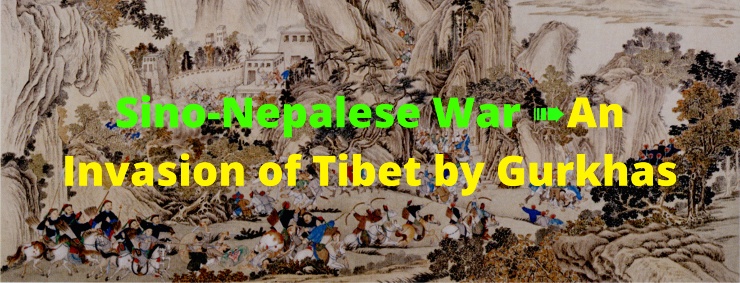
The Sino-Nepalese War was initially fought between the Kingdom of Nepal (Gorkhas or Gurkhas) and Tibet under the Qing Dynasty over a long-standing dispute regarding the manufacture of poor quality silver coins by Nepal. The campaign of Gorkhas (In Chinese) was an invasion of Tibet by Nepalese from 1788–1792.
Tibetans when suffered heavy casualties in battle at Shikarjong against fearless Gorkhas led under Bahadur Shah, requested Nepalese Army to have a peace treaty and decided to pay annual tribute to Nepal. As mentioned in the Treaty of Kerung Tibetans paid a sum of Rs. 50,001 to Nepal as the first installment. However, refused to pay tributes next year and requested for Chinese intervention and the Nepal -Tibet war turned into a war between Nepal and the Qing Empire.
The Principal causes of Sino-Nepalese War
The immediate cause of the Nepal-Qing war of 1792 was an attack of Nepal on Digarcha and the arrest of the minister of Lhasa, Dhoren Kazi in response to Disregard to the Peace Treaty of Kerung from the Tibetans side. The other considerable principal causes that led Sino-Nepalese are
Production of low-quality silver coins mixed with copper by Nepal for Tibet
Nepal and Tibet had been good neighbor kingdoms through kind relationships and royal marriages from a very long ago and Nepal has been manufacturing silver coins for Tibet since the Malla dynasty. When Prithvi Narayan Shah of the Gorkha Kingdom started unification campaign of unifying all of Nepal that would form modern and lost territories by launching an economic blockade on Kathmandu Valley (Capital of Current Nepal), Kathmandu faced a huge economic crisis. To overcome the crisis king Jaya Prakash Malla started minting low quality of silver coins mixed with copper.
You may like: How Nepal was formed? Anglo-Gurkha war and British Colonization?
After the defeat of King Jaya Prakash Malla by Prithvi Narayan Shah in 1769 followed by the establishment of Shah dynasty in Nepal, King Prithvi Narayan Shah reverted minting process back to pure silver coins.
Tibetans continuity in providing low quality salt to Nepal
During seventeen century almost all of the salt for Nepal was imported from Tibet. When Prithvi Narayan Shah rejected Tibetans demands they started supplying low quality salt to Nepalese merchants.
By 1788 Bahadur Shah uncle of minor king Rana Bahadur Shah (grandson of Prithvi Narayan shah) sent a delegation team to Tibet to resolve existing conflicts and maintain peace and friendship, but the demands made by the Nepal were rejected by the Tibetans.
Harassment of Nepalese traders in Tibet
As the rumors created by Tibet that it was in position to get victory over Nepal Tibetans they started harassing Nepalese traders which further pushed relationships away.
Bahadur Shah found unresolved coinage problem and Tibetans continuity in providing low quality salt a good pretext to expand Nepalese kingdom to North side and a good opportunity to raid the rich monasteries in Tibet. Thus, Nepal launched multi-directional attacks on Tibet.
First Campaign Against Tibet- Invasion of Tibet By Nepal
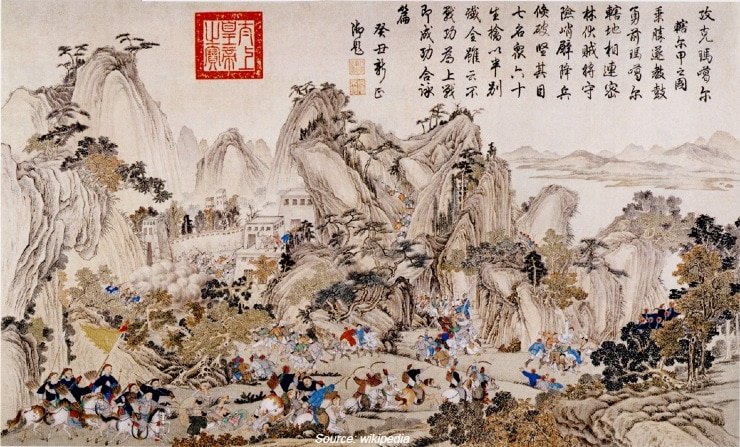
Consuming the very best opportunity to expand the Kingdom of Nepal, In the year 1788, Bahadur Shah launched an attack on Tibet by sending Nepalese best troops under the joint command of Damodar Pande and Bam Shah and marked beginning of the Sino-Nepalese War. As planned the Gurkhas entered Tibet through a town known as Kuti (Nyalam Town) and reached as far as Tashilhunpo (about 410 km from Kuti).
A ferocious battle was fought at Shikarjong in which the Tibetans suffered heavy casualties and defeated badly. The Tibetans have no choice rather than making a peace treaty with Nepal and accept their conditions. So the Panchen Lama and Sakya Lama then requested the Nepalese Army to have peace talks. Therefore, the Nepalese left Shikarjong and went towards Kuti and Kerung (Gyirong).
As soon as the Qianlong Emperor of China came to know about the invasion of Tibet by Nepal, he sent a large Chinese army under the command of General Chanchu to get back control over Tibet. When Chanchu reached Tibet, he was made aware of the situation from the Tibetan Lamas and decided to stay there till the dispute gets settled.
Related: Is Nepal Older Than India? Which Country is Elder Brother?
It was settled both of Tibet and Nepal to meet at Khiru in 1789 to have peace talks. A Peace treaty was signed by both sides called the Treaty of Kerung, Tibet was held responsible for the war and was required to give compensation to Nepal for the losses acquired in the war. Also as mentioned in the treaty Tibet would have to pay tribute to Nepal a sum of Rs. 50,001 every year in return for giving back all the captured territories.
The Nepalese representatives received Rs. 50,001 as the first installment and all the acquired territories – Kerung, Kuti, Longa, Jhunga, and Falak, were returned to Tibet by Gurkhas. Eventually, the Sino-Nepalese War came to a peaceful end But when Tibetans refused to pay the tributes the next year the war between Nepal and Tibet continued.
Greater Nepal with Nepalese Tibetan war Expansions
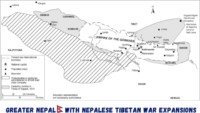
Qing Dynasty
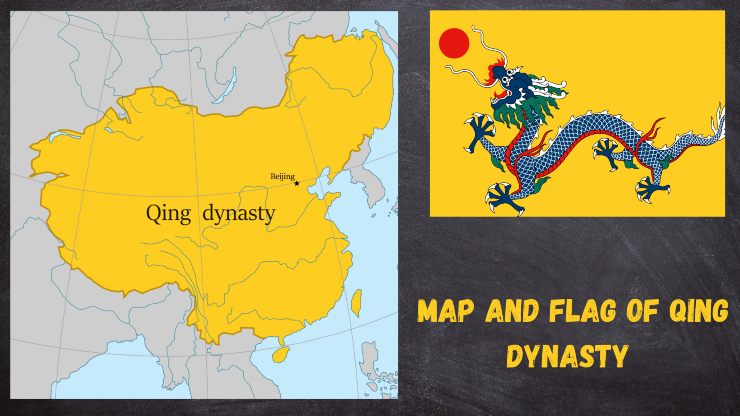
The Qing dynasty, officially the Great Qing, was the last imperial dynasty of China. It was established in 1636 and ruled China proper from 1644 to 1912. It was preceded by the Ming dynasty and succeeded by the Republic of China
Second Invasion- A Campaign Against Gurkhas
As Tibet, had refused to pay the tribute to Nepal, By 1791 Bahadur Shah sent few Gurkha warriors under Abhiman Singh Basnet to Kerung and some other under the command of Damodar Pande to Kuti. As planned Damodar Pande launched an attack on Digarcha and captured the property of the monastery there. He returned Nepal with the minister of Lhasa, Dhoren Kazi as a hostile. As soon as Qianlong Emperor get to know about the Nepalese attack, he sent an army of his best 70,000 soldiers under the command of Fuk’anggan to revert the attack on Gurkhas. Thus, in the 1792 war between Nepal and Tibet turned into Nepal -Qing empire war.
At first, Qianlong Emperor requested Nepal to release Shamarpa Lama who had taken asylum in Nepal and the looted property at Digarcha. But Nepal was in no thought to return looted property and agree to Chinese demands. Thus, the Qing imperial army responded to Nepal with military intervention.
They forced Nepalese to fall back to the banks of the Trishuli River until they reached Nuwakot. The outnumbered Gorkhali force of 10,000 attempted to defend against the Qing attack but were already faced with overwhelming odds. Heavy damage was suffered by both sides and the Chinese army successfully pushed Gurkhas back to the hills nearer to the capital. However, a comprehensive defeat of the Nepalese army could not be achieved.
At the same time, Nepal was dealing with military confrontations with Sikkim in the eastand Garhwal in the west. Even Within Nepal’s own borders, the kingdoms of Achham, Doti and Jumla started revolting. So, it became much difficult for Nepal to defend against the Qing army.
After a series of successful battles, the Chinese reached Nuwakot (A place nearer to capital Kathmnadu) but they suffered a major hindrance when they tried to cross heavy flooded Betrawati river, nearer to Gorkhali palace. As the Qing Army, had already reached south of the river, it wasn’t any good for Nepalese to wait for them to attack Kathmandu.
Thus, on September 19, 1792, Bahadur Shah with the Nepalese force of less than 200 Gurkha warriors decided to counterattack against the Qing army at Betravati and at Jitpurfedi. The Nepalese came up with a great tactic to defend against the Qing Emperor. The Gurkhas lit their torches tied them to the branches of trees. Also, they drove a large group of animals with torches tied to horns towards the enemy. Ultimately Nepalese succeeded in defeating the Chinese Army.
Read Related: Why Britain never succeeded in Colonizing Nepal?
A vicious battle was fought at three forts (Chokde, Dudethumko, and Gerkhu) nearer to Betrawati river. The command to handle force at Gerkhu, was given to Kaji Kirtiman Singh Basnyat and the responsibility of defending Chokde was handed to Kaji Damodar Pande. The Chinese army suffered heavy repulse from Nepalese forces at all of three forts and were forced to retreat to Betrawati river. When Chinese General Tung Thyang realized that they had already lost many men and can’t stand much longer to get help, he decided to conclude a treaty with Nepal through a letter.
In reply, the government of Nepal issued a royal order deputing Kaji Damodar Pande to conclude a treaty with the Chinese Emperor to prevent further hostility and maintain peace with the Qing Dynasty. The royal order issued by King Rana Bahadur Shah to Kaji Damodar Pande is detailed below( As mentioned in Wikipedia page: Sino-Nepalese War)
From King Ran Bahadur Shah,
To Damodar Pande,
Greetings. Everything is well here. We desire the same there. The news here is good. The Chinese Emperor is not insignificant. He is a great Emperor. We could have repulsed them with the blessing of (Goddess Shri Durga) when they came here this time. But it will not be good for the future to maintain hostility with the Emperor. He too desires to conclude a treaty, and that is what we desire. Tung Thwang has sent a letter asking that one of the four Kajis be sent with letters and presents to offer his respects to the Chinese Emperor. Kajis used to be sent formally to conclude treaties with Tanahu and Lamjung. We realize at present that it will not be proper for us not to depute a Kaji to the Emperor. When the matter was discussed with the other Kajis here, they said that Damodar Pande, the recipient of Birta (land) grants and senior-most Kaji, should go. So, you have to go. If there is any delay, (the interests) of the state will be harmed. You should therefore depart from there. So far as instructions are concerned, you are a Pande of our court. You are not ignorant of (matters) which will benefit the State and bring you credit. You know (such matters). In this respect, act per your discretion. Submit a reply to this soon, within 1 Ghadi (Equivalent 24 minutes) after you receive this royal order. Any delay will be harmful.
Royal order issued by King on Thursday, Bhadra Sudi 13, 1849 (September 1792)Royal order issued by King on Thursday, Bhadra Sudi 13, 1849 (September 1792)
A stalemate ensued, and with Nepalese resources low and a looming uncertainty regarding how long they would be able to hold on in addition to the need to continue their expansion drive on the western frontier, the Gurkhas signed a treaty on terms dictated by the Qing Emperor and Sino-Gorkha War came to its peaceful end.
Peace treaty between the Kingdom of Nepal and Qing Empire
On 2 October 1792, Qing general Fuk’anggan sent a proposal to the Bahadur Shah which officially gave an end to the Sino-Nepalese War. A friendly treaty was signed by both sides at Betravati with the terms:
- Both Kingdom of Nepal and Tibet will accept the suzerainty of the Qing emperor.
- The Qing will help Nepal to defend against any external aggression.
- The Government of Tibet will pay compensation of the property looted by the Tibetans at Lhasa.
- The Qing Emperor will interfere in case of any dispute between Nepal and Tibet, only on request of both kingdoms.
- The Nepalese citizens will have the right to visit, trade, and establish businesses in any part of Tibet and China.
- Every five years both Nepal and Tibet will send a delegation to pay tribute to the Imperial Court in China.
- In return, the Qing emperor will frequently send friendly gifts to both Nepal and Tibet and the people visiting China to submit compensation will be considered royal guests and their every need will be fulfilled.
You May Like: Battle of Nalapani | An Epic Battle Fought by 600 Gurkhas
However, the treaty eventually stopped the Sino-Nepalese War and maintained peace for around 50-60 years until the Nepalese–Tibetan War of 855 -1856. The weakening of the Qing Dynasty during the 18th and 19th centuries led to the fall of the treaty. Not only, the Qing emperor failed in helping Nepal during the Anglo-Nepalese War of 1814-16 against Britain but also, they failed to prevent the capture of Nepalese territory by the British. The absence of china in the Nepal-Tibet war of 1855-56 increased disregard of the peace treaty made between Nepal and Qing.
Note: All the images and information used in the post are brought from the Wikipedia page on the Sino-Nepalese War.
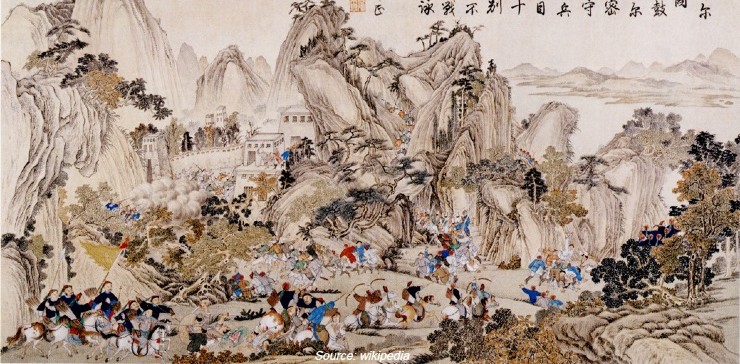
Want to know more on Tibetan history and relation with India